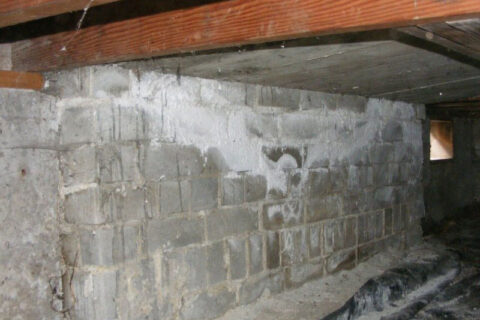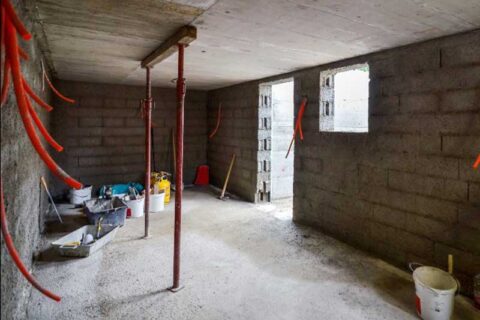What to Do if Your House Floods
A basement flood is one of a homeowner’s worst nightmares. We often talk about prevention when it comes to basement flooding but what if it is too late to talk about waterproofing applications? The Federal Emergency Management Agency (FEMA) put together an information packet about things to know and what to do as a homeowner to repair your home after a flood. Most of the cleanup you can do yourself. However, some cleanup and repairs should be done by a professional.
Go Inside Carefully
If your house is flooded it may be hard to enter. The doors will probably be swollen from soaking in the flood water. If it only sticks at the bottom, it can be forced open. If it sticks at the top, your ceiling may be ready to fall. You can force the door open, but wait outside the doorway for a minute where you will be protected if something falls.
If the door won’t open easily, it may be easier for you to enter your home through a window. Look carefully at the ceiling before you go in to be sure it is not ready to fall.
FEMA warns against smoking or using candles, gas lanterns, or other open flames in your home. There may be explosive gas in your home. Air out your home completely.
Carefully Drain Your Basement
If your basement is flooded, don’t be in too big a hurry to pump it out. Here’s why.
Water in the ground outside your home is pushing hard against the outside of your basement walls. But the water inside your basement is pushing right back.
If you drain your basement too quickly, the pressure outside the walls will be greater than the pressure inside the walls—and that may make the walls and floor crack and collapse, causing serious damage.
To avoid this situation, follow these steps when you pump the water out of your basement:
After floodwaters are no longer on top of the ground, you can start pumping the water out of the basement. Do not use gasoline-powered pumps or gen¬erators indoors because gasoline engines create deadly carbon monoxide exhaust fumes.
Pump the water level down 2 to 3 feet. Mark the level and wait overnight. Check the water level the next day. If the water went back up, it’s still too early to try to drain the basement. Wait overnight again. Then pump the water down 2 to 3 feet again. Check the level the next day.
When the water stops going back up, pump down another 2 to 3 feet and wait overnight. Re¬peat steps 4 and 5 until all water is pumped out of the basement.
Lower the Humidity
Once all the water is pumped out you will need to lower the humidity level. Everything will dry more quickly and clean more easily if you can reduce the humidity in the home. Use a heavy duty dehumidifier to control the moisture level before mold begins to grow.
Cleaning up the Mud Left Behind
The mud left behind by floodwaters contains most of the health hazards you will face. It is very important to get rid of the mud as soon as possible. This is a lot easier if it is done before the mud dries out.
Shovel out as much mud as possible. Check your water system for leaks from pipes that may have moved. Even if your water supply is not safe to drink, it can be used for cleaning the home. If you have water, hose the home down, inside and out. If you have an attachment that sprays soap, wash and then rinse the walls and floors. Hose the furniture and other major items that got muddy.
Heating and air conditioning ducts that got flooded will have mud left in them. If you don’t clean them out, your system will be blowing foul, dusty air that contains the same health hazards you are trying to get rid of. To clean the ducts, remove the vents or registers. If possible, remove some sections of the ducts in the basement or crawlspace to give you access to all areas. Then thoroughly hose out all the ducts.
While you hose the walls, thoroughly hose out the electrical outlet, switch boxes, and light sockets that you opened up.
After you hose out the duct work to remove the mud, wash it with a disinfectant or sanitizer. If your ducts are in a slab or are otherwise inaccessible, have them cleaned by a professional.
Don’t let the water sit on the floor for long, especially if your floor has particle board or other wood product that tends to fall apart when wet. Use a mop, “wet vac,” or squeegee.
Check for Structural Damage
You need to find out whether there is any structural damage to your home. (You will probably need a professional foundation repair contractor to help in making this decision.)
Is there evidence of broken or cracked basement or foundation walls? Are there broken pilings, shifted stairs, or slanted floors or walls? Any of these things could mean that the foundation, floors, or walls will have to be totally rebuilt. Repair safety hazards such as broken pilings or an undermined foundation before you proceed any further. Get professional help for any task you cannot confidently do yourself.
You will need a building permit to repair structural damage. Talk to your local building department before you start reconstruction or sign any repair contracts. If the damage to your home’s structure exceeds 50 percent of the market value of your home, most local building codes will require you to elevate it above flood levels. Some may not allow you to rebuild at all.
If you are allowed to rebuild your home, make sure you install the proper waterproofing precautionary systems so this never happens again. Install an interior drainage system and sump pumps and emergency back-up sump pump systems. It is also important to fix any cracks in the foundation and wall joists to ensure the foundation will not let water in. If it does your sump pump system will drain any water. Whether a flood was caused by an act of nature or human error, it can be prevented by installing the proper waterproofing and basement drainage system. Remember, once you install a good waterproofing system for your home, take good care of it. Maintain it and make sure it is in good working condition so you will be prepared if a flood ever hits your home again.
Ready to Get Started?
Contact Us Today to Schedule a No Pressure, No Obligation, Free Quote!


